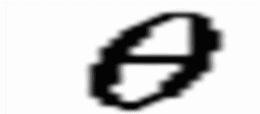Problem 4:
A constant force F = (3.0 N)i - (2.0 N)j is exerted
on an object which moves from r1 = (1.0 m)i -
(3.0 m)j to r2 = (4.0 m)i +
(5.0 m) j.
What is the work done by this force on the object?
[bonus question (5 points) - do this part only if you have finished
the rest of the test!]
What is the angle between the vector F and the
displacement vector?
Solution:
- The work is the dot product (scalar product) of the force and the displacement.
-
- W = F ·
 r
r
- The displacement is
-
 r = r2 -
r1
r = r2 -
r1
- = [(4.0 m)i + (5.0 m) j] - [(1.0 m)i -
(3.0 m)j]
- = 3.0 m i + 8.0 m j
- so
- W = [(3.0 N) i - (2.0 N) j] · [3.0 m i + 8.0 m j]
- = (3.0 N)(3.0 m) + (-2.0 N)(8.0 m) = -7 Nm = -7 J
- The negative sign indicates that the force takes energy away from the
object. Possibly other forces acted on the object during its motion...
- Bonus: We can find the angle using the work we have just calculated, since
W = Frcos
 . We find the magnitudes of
the force and the displacement:
. We find the magnitudes of
the force and the displacement:
- F = [(3.0 N)2 + (-2.0 N)2]1/2 =
3.61 N
-
 r = [(3.0 m)2 +
(8.0 m)2]1/2 = 8.54 m
r = [(3.0 m)2 +
(8.0 m)2]1/2 = 8.54 m
- Thus
- cos
 = (-7 J)/[(3.61 N)(8.54 m)]
= -0.2272
= (-7 J)/[(3.61 N)(8.54 m)]
= -0.2272
-
 = 103.1°
= 103.1°
Note:
This was essentially the same as
6-20 from the homework. The bonus
portion was done as an example in the lecture.
Test 2 page
Physics 101 Home page
Physics Department Home Page
College of William and Mary,
Dept. of Physics
armd@physics.wm.edu
last updated: Oct. 20 2000